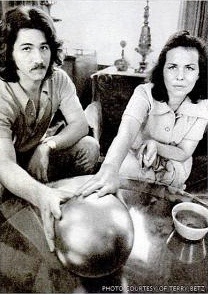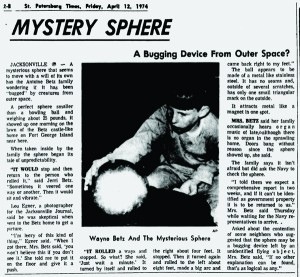
When the Betz family was examining the damage of a strange fire that had decimated 88 acres of their woodland, they made a strange discovery: a silvery sphere, about 20 centimeters (eight inches) in diameter, completely smooth except for a strange, elongated triangle symbol. Initially thinking it might be a NASA gadget or even a Soviet spy satellite, they eventually decided it was most likely just a souvenir. On a moment’s whim, they decided to take it with them.
Two weeks later, the family’s son was strumming a guitar in the same room as the sphere. Suddenly, the sphere started reacting to his tunes, emitting a strange throbbing sound and a resonance that deeply disturbed the family’s dog. Soon, the Betz family found the orb had other strange properties. It could stop and change directions when pushed across the floor, eventually returning to the person who pushed it like a faithful dog. It seemed to draw power from solar energy, becoming noticeably more active on bright days.
It started looking like something (or someone) was controlling the sphere: It would occasionally emit low-frequency rattling and vibrations, like there was a motor running inside. It seemed to avoid falling and crashing at all costs, as if to protect something inside it. It even managed to completely defy the laws of gravity and climb up a slanted table to avoid falling.
A media frenzy ensued. Respected papers such as the New York Times and the London Daily sent reporters to witness the miracle sphere, which repeated its tricks to countless people. Even scientists and representatives of the military were impressed, although the Betz family wouldn’t let them take the sphere for closer examination. However, that soon changed as the sphere took a turn for the worse. It started exhibiting poltergeist–like behavior: Doors started slamming shut at night and strange organ music would fill the house out of the blue. At that point, the family decided to find out what the sphere really was. The Navy analyzed it and found it was . . . a perfectly ordinary (if high-quality) stainless steel ball.

To this day, it’s not entirely clear what the mysterious alien sphere is. However, there have been many theories attempting to explain its possible nature. The most plausible of these is, incidentally, the most mundane: Three years before the Betz family found the orb, an artist named James Durling-Jones was driving in the area where it was found. On the luggage rack on his car roof were a number of stainless steel balls meant for a sculpture he was making, some of which dropped off during the bumpy ride. These balls matched the exact description of the Betz sphere, and were balanced enough to roll around at the slightest provocation (the Betz family lived in an old house with uneven floors, so such a ball would appear to behave erratically). These balls could even emit a rattling sound, thanks to tiny metal shavings stuck inside during the manufacturing process.

It was March 27, 1974, and members of the Betz family were in Florida, inspecting the damage done by a small brushfire near their property on Ft. George Island. The island is a patch of dry ground among the coastal marshlands of northeastern Florida, well timbered with beautiful moss-draped trees and tropical scrub. Antoine and Jerri Betz, accompanied by their 21-year-old son Terry, happened to stumble upon a surprising object: a bright metal globe, about the size of a bowling ball, just sitting there in the grass. It was quite heavy, but otherwise unremarkable. They guessed it might have been an old cannonball; the island has a long history going all the way back to a 16th century Spanish mission. For whatever reason, they liked the ball and decided to take it home. And that’s when the Betzes’ lives changed.
It began when Terry was playing guitar. The family reported that the ball strangely resonated the music. And then it began to move around, all on its own. The Betzes experimented with it, placed it on their table, and watched it navigate its own way around the perimeter without falling off. Doors began slamming themselves around the house. Mysterious organ music filled the residence, even though there was no organ. Finally the Betzes had had enough, and contacted the newspapers in the hope that someone might tell them what the bizarre artifact was.
The Jacksonville Journal sent a photographer, Lou Egner. Mrs. Betz told him to put the sphere on the floor:
“It rolled a ways then stopped. So what? She said, ‘Just wait a minute.’ It turned by itself and rolled to the right about four feet. It stopped. Then it turned again and rolled to the left about eight feet, made a big arc and came right back to my feet.”
What followed was something of a media frenzy. One of the many callers was Carl Willson from a holistic institute in Baton Rouge, LA called Omega One. Willson spent six hours examining the ball at the Betz home, and reported not only that it had a powerful magnetic field, but it was also transmitting a radio signal.
Mrs. Betz then called the US Navy base directly across the water from the island and asked if they could examine it; perhaps it was theirs. They did so, but returned it to the Betzes once they verified that it was not Navy property. They X-rayed it and did a metallurgical test and found it to be high grade yet common stainless steel; hollow with a shell approximately 1/2 inch thick (about 13 mm); measured 7.96 inches in diameter (202.2 mm); and weighed 21.34 pounds (9.68 kg). The numbers added up, it was the right weight for that much stainless steel. Its surface was scuffed but seamless, with only one identifying mark: a tiny triangle about 3mm long.
Following the wave of newspaper reports, Dr. J. Allen Hynek, a UFOlogist and astronomer at Northwestern University in Chicago, contacted the Betz family and asked to examine the ball. However since he was all the way up in Chicago, and they were all the way down in Florida, nobody wanted to take the risk of shipping it. But as luck would have it, Dr. Hynek was in New Orleans, LA the following week for a meeting with the National Enquirer tabloid, which was establishing a $50,000 prize for definitive proof of aliens. Since Hynek and several other scientists on the Enquirer’s panel were all there, Terry Betz and his sister drove out from Florida to show them the ball in person.
Could these be bladder tanks used on spacecraft. These stout metal spheres contain a flexible bladder full of rocket fuel such as hydrazine, and the sphere is filled with pressurized gas to keep a constant squeeze on the bladder. When fuel is needed, a valve opens and the fuel squirts out. These tanks have a reputation for surviving when spacecraft deorbit and burn up on reentry. One fell on Namibia in 2011, generating some headlines, and reporters noted that there have been many other such cases over the decades.
Bladder tanks are usually a little bigger and lighter than the Betz sphere, but they’re in the general ballpark. However, they have obvious couplings where the fuel comes out, and the Betz sphere’s only marking was much too small and completely inconsistent with a large valve coupling. It was not a bladder tank.
Some authors, also following the assumption that it fell from outer space, have suggested that it was Sputnik, or a Sputnik-like satellite. This was largely based on what Carl Willson had said, that it transmitted a radio signal. But the ball was a poor match for Sputnik. It had no antennae, seams, rivets, mechanical connections, or anything else that characterized Sputnik’s globe.
The Palm Beach Post reported on April 18 that Lottie Robinson recognized the ball from the pictures, then went and got her own out of the garage where it had sat for some 15 years. Technicians from the St. Regis Company paper mill identified it as a ball valve from some large pipes used in their factory, and that had been scrapped 15 years before. Somehow that ball had found its way from a scrap dealer to Mrs. Robinson’s son, and from there to her garage. It was very close, but not identical, in size and weight to the Betz sphere.
Seeing this, Robert Edwards, president of a Jacksonville, FL equipment supply company, picked up the phone. He showed a UPI reporter a brand new stainless steel ball, manufactured by Bell & Howell in Bridgeport, CT. Edwards and the reporter uncrated it, weighed and measured it, and found that it was 8 inches across and weighed just over 21 pounds…exactly the same as the Betz sphere.
“I’m not saying that this thing didn’t come from outer space because I’ve never seen it,” said Edwards. “All I’m saying is that the physical description of it matches exactly the type of ball we have in stock.”
The Navy metallurgist had identified the ball as being made of an alloy called stainless steel 431. According to the web site of a supplier of this alloy:
431 has been successfully used in a variety of aircraft and general industrial applications. These include fasteners, bolts, valve components and chemical equipment.
But how could a ball with such amazing properties — moving by itself, rolling uphill, making organ music, and transmitting radio signals — be just an ordinary piece of industrial machinery?
There are many published news reports of the incident, and from these reports, we can glean that what the Betzes reported at the time is considerably less remarkable than what is now claimed on some of the paranormal websites that promote the Betz sphere as an alien artifact. For one thing, the ball sat quietly on display inside the Betz home for nearly two weeks, and is not reported to have ever moved on its own at all, except for when someone took it down to experiment with it. Neither the US Navy nor J. Allen Hynek reported observing the ball do anything unusual whatsoever. Neither corroborated Carl Willson’s assertion that it had odd magnetic properties, or that it was broadcasting a radio signal. The only thing Hynek and his fellow Enquirer panelists noted was that it rattled when shaken.
The Betz story even has an elegant thread that ties it full circle, which is not something we always find on Skeptoid: how the ball came to be on Ft. George Island in the first place. After the story broke, a Coca-Cola delivery man saw some similar looking spheres in a sculpture outside the hotel managed by artist James Durling-Jones in Taos, New Mexico. He called Durling-Jones’ attention to the newspaper stories about the Betz sphere. Soon, reporters were calling him to ask about his 8-inch stainless steel globes. It turns out he had several sculptures that used them, including a kinetic sculpture using one as a pendulum.
He’d made a run a few years back in his Volkswagen bus, collecting scrap metal for his sculptures. A friend had supplied him with a number of balls from large industrial ball valves at his company, in two sizes: some 8-inch balls weighing about 22 pounds, and some 10-inch balls weighing about 70 pounds. Having no room left inside the VW, Durling-Jones put the balls on a luggage rack up on top. He drove through the Jacksonville area around Easter of 1971, at which time a few of the balls rolled off the luggage rack and were lost. And there it sat for three years until the Betzes happened along.

![20131206-012603[1]](https://coolinterestingnews.com/wp-content/uploads/2013/12/20131206-0126031.jpg)












